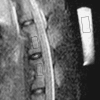Dynamic contrast enhanced-magnetic resonance imaging study of the nutrition pathway for lumbar intervertebral disk cartilage of normal goats
- PMID: 22009595
- PMCID: PMC6583276
- DOI: 10.1111/j.1757-7861.2011.00123.x
Dynamic contrast enhanced-magnetic resonance imaging study of the nutrition pathway for lumbar intervertebral disk cartilage of normal goats
Abstract
Objective: Study of the nutrition pathway for lumbar intervertebral disk cartilage of normal goats.
Methods: Four lumbar intervertebral disks from each of eight 24-month-old goats (32 disks) were studied. After the goats had been anesthetized, signal intensity changes in the regions of interest (ROI) were observed by dynamic contrast enhanced magnetic resonance scanning. Before and after enhancement at the time points of 0, 5, 10, and 30 mins, and 1.0, 1.5, 2.0, 2.5, 3.0, and 3.5 hs, the ROI signal intensity was measured, and the time-signal intensity curve and peak times analyzed.
Results: Signal intensity in the vertebral bodies reached a peak at 0 min and decreased quickly thereafter. Signal intensity in the cartilage endplate zones reached the first peak at 30 mins and then went down slightly before increasing to a second peak at 2 hs. Signal intensity in the nuclei pulposus was negative within 5 mins, increased slowly to a peak at 2 hs, and declined thereafter.
Conclusion: Nutrient metabolism of the lumbar intervertebral disks of normal goats occurs mainly through the cartilage end-plate pathway.
© 2011 Tianjin Hospital and Blackwell Publishing Asia Pty Ltd.
Figures




Similar articles
-
Pharmacological enhancement of disc diffusion and differentiation of healthy, ageing and degenerated discs : Results from in-vivo serial post-contrast MRI studies in 365 human lumbar discs.Eur Spine J. 2008 May;17(5):626-43. doi: 10.1007/s00586-008-0645-6. Epub 2008 Mar 21. Eur Spine J. 2008. PMID: 18357472 Free PMC article.
-
Intervertebral disk degeneration related to reduced vertebral marrow perfusion at dynamic contrast-enhanced MRI.AJR Am J Roentgenol. 2009 Apr;192(4):974-9. doi: 10.2214/AJR.08.1597. AJR Am J Roentgenol. 2009. PMID: 19304703
-
ISSLS prize winner: A study of diffusion in human lumbar discs: a serial magnetic resonance imaging study documenting the influence of the endplate on diffusion in normal and degenerate discs.Spine (Phila Pa 1976). 2004 Dec 1;29(23):2654-67. doi: 10.1097/01.brs.0000148014.15210.64. Spine (Phila Pa 1976). 2004. PMID: 15564914
-
Enhancement of intervertebral disks with gadolinium complexes: comparison of an ionic and a nonionic medium in an animal model.AJNR Am J Neuroradiol. 1994 Nov;15(10):1907-10. AJNR Am J Neuroradiol. 1994. PMID: 7863940 Free PMC article.
-
[VERTEBRAL SUBCHONDRAL BONE AND INTERVERTEBRAL DISC DEGENERATION].Zhongguo Xiu Fu Chong Jian Wai Ke Za Zhi. 2015 Mar;29(3):377-80. Zhongguo Xiu Fu Chong Jian Wai Ke Za Zhi. 2015. PMID: 26455209 Review. Chinese.
Cited by
-
Inhibition of both endplate nutritional pathways results in intervertebral disc degeneration in a goat model.J Orthop Surg Res. 2019 May 16;14(1):138. doi: 10.1186/s13018-019-1188-8. J Orthop Surg Res. 2019. PMID: 31096992 Free PMC article.
-
Indian hedgehog contributes to human cartilage endplate degeneration.Eur Spine J. 2015 Aug;24(8):1720-8. doi: 10.1007/s00586-015-4000-4. Epub 2015 May 10. Eur Spine J. 2015. PMID: 25958162
-
Hypoxia-inducible factor (HIF)-1alpha knockout accelerates intervertebral disc degeneration in mice.Int J Clin Exp Pathol. 2018 Feb 1;11(2):548-557. eCollection 2018. Int J Clin Exp Pathol. 2018. PMID: 31938140 Free PMC article.
References
-
- Adams MA, Roughley PJ. What is intervertebral disk degeneration, and what causes it? Spine, 2006, 31: 2151–2161. - PubMed
-
- Andersson GB. Epidemiology of low back pain. Acta Orthop Scand Suppl, 1998, 281: 28–31. - PubMed
-
- Adams MA, Freeman BJ, Morrison HP, et al Mechanical initiation of intervertebral disk degeneration. Spine, 2000, 25: 1625–1636. - PubMed
-
- Gruber HE, Hanley EN Jr. Recent advances in disk cell biology. Spine, 2003, 28: 186–193. - PubMed
-
- Nerlich AG, Schleicher ED, Boos N. 1997 Volvo Award winner in basic science studies. immunohistologic markers for age‐related changes of human lumbar intervertebral discs. Spine, 1997, 22: 2781–2795. - PubMed
MeSH terms
Substances
LinkOut - more resources
Full Text Sources

